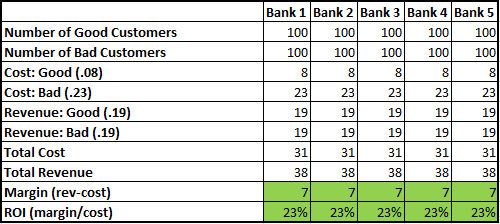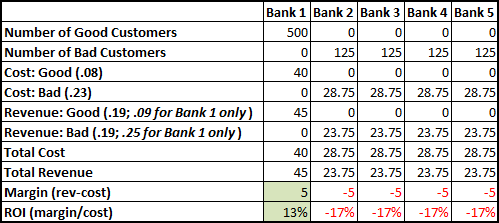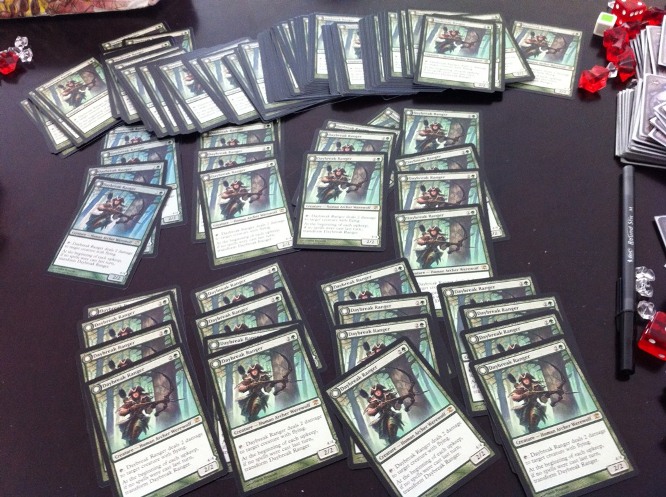Which 3.5 cards will change how Standard Magic is played?
There are two kinds of very good Magic cards (at least two, that is… But I honestly think “just” two). One of those is the card like a Gitaxian Probe or a Preordain or even a Lightning Helix. These are cards that see lots of play and make decks better, and often they are aggressively costed relative to their impact on deck performance; in the case of a card like Preordain you can see a spell whose inclusion in-archetype separates the men from the buffoons… But even so, they don’t really change the nature of the landscape, other than the fact that they see lots of play.
Now on the other hand, you have cards that genuinely change the nature of the metagame, or how the game is played—at least in the extremes—on a fundamental level. These cards may or may not be as good or “better” than the cards from the other camp (that is, drawing or playing them in the course of a game may or may not correlate with victory at a greater clip), but they put up signposts that mark the borders of the metagame, even change what kinds of cards can be played at all… That is, they can completely alter the way people choose their spells.
An easy example might be Tooth and Nail, and some really good, if less flamboyant, ones might be Dismember or Jace, the Mind Sculptor. Dismember is so good—and at this point so ubiquitous—that it completely re-writes the notion of what kinds of creatures you want to play.
Brian Kibler switched out of playing “any kind of interesting” creatures, moving to Blade Breaker’s 187s and hasty instant gratification set (why invest mana when the opponent can answer it for just one?) out of frustration against Dismember’s mindboggling cost and availability.
Same deal on Jace, the Mind Sculptor. Shouldn’t Phyrexian Obliterator be one of the greatest midrange control creatures of all time? Because of the existence of Jace and then the appearance of Dismember, instead it continues to be next to unplayable.
Innistrad is a set that offers a surprisingly tremendous number of cards in this latter camp. Some of the newbies are so simple—and yet so unbelievably paradigm shifting—that… Well, I’ll just get to what seems interesting to talk about and leave you to judge.
But first, a metaphor; it is not 100% “historically accurate,” rather accurate enough that at least some of you know what I am hinting at, but designed to be useful for anyone with a passing understanding of applied mathematics, incentive, good marketing, and ruthless American capitalism.
Imagine for a moment you can dial back the clock a couple of decades and that you are suddenly in charge of some particular kind of financing (not saying which kind) at a large, innovative, and actually quite reasonable national bank. Now at the time our story begins, everyone charges everyone, say 19%. Tom 19%. Dick 19%. Harry 19%. Even Jane: 19%. Everyone wants the kind of product we are talking about, but not everyone actually qualifies. If a customer is actually eligible, any and all providers are going to charge her 19%.
Again, you are a very company executive, and you [hire some math nerd / whiz to] have this amazing idea. There is quite a big difference between, say, Tom and Dick. That is, there are low risk (desirable) prospects and higher risk (though not necessarily “horrible”) prospects, as both fall beneath the umbrella of a reasonable provider’s acceptable risk portfolio. That is, you can make money on both, on a blended basis, and you need the second group to scale your efforts.
The average “good” candidate costs you about 8%, and the average “bad” one costs you about 23%. If a provider has, on average, half good and half bad customers, the 19% blend actually makes money.
You have this market-bending idea—backed up by piles and piles of reliable data—to charge Tom only 9%. Now you can’t reasonably just slash terms “everywhere” by 50%, so to balance your portfolio you have to theoretically charge Dick a whopping 25%. Keep in mind that you are annihilating your margin on good customers, per-customer, by taking this action, and that you have to raise prices on the others in order to afford the plan.
Put yourself in Tom’s shoes. Put yourself in every Toms’ shoes. You are a low-risk candidate with a good job and a little money in the bank. You see the right flyer in the right window, or the right commercial during the right Sunday afternoon football game, and learn about one of these newfangled 9% financing widgets. This, my friends, is marketing at its best: the connection of real value to the right consumer in a mutually beneficial way. Congratulations! You look to be a great candidate! We want to work with people exactly like you!
Now there is Dick. Dick does not qualify for one of your shiny proto-iPad2-like 9% Next Big Thing(s). Do you still want a piece, Dick? For you… 25%.
Now imagine you are my man Dick. How quickly are you going to flip the bird to fancyman bank man? “25%? No way! I can get the exact same thing for 19% anywhere the hell else!”
So what happens?
As the innovative provider and first mover, you attract EVERY “good” candidate. Theoretically all of them. Why should one of the so-called desirable prospects pay 19% anywhere else when they can pay you 9%? And unbelievably, you might have even some saps on 25%. Your ROI goes down by double digits, but your volume skyrockets to perhaps 50% of the entire market.
At the same time, there is a whole universe of people who would qualify for our desirable-but-unnamed financing who have no interest in paying you 25%. Where do they go? Anywhere the eff else.
So not only do you attract all the “good” candidates, but you flood your competitors with all 100% of the less desirable ones. Unless there is some compelling reason (Tom’s sib Jerry works at a different bank and he is doing a brother a solid), if a rational consumer / eligible potential has heard of your bank / your offer, he is going to be your customer. The oppositions’ existing financial models are predicated on obtaining a mix of customers—some good, some bad; some of the so-called 8% customers (where they make a killing) and some of the so-called 23% ones (where they lose, on average), though “all” are meant to mix into a cake batter of economic acceptability—where they make margin against the, say, 15.5% blend… but now they have only high-risk customers in their portfolios.
Bound by the traditional forces of the market, you should be getting killed, having slashed your overall ROI by, again, double digits. However the financial landscape can be thought of as a butcher shop. You no longer have French ringholes in your sausage. There is no scrapple on your floor any more, as you have swept it all next door. There are no substandard cuts, no mad cows-to-be gunned down in the field before they can fall down on their own. The entirety of your shop is kurobuta pork and 21-day aged hunks of blue stamped prime beef, woven with melt-in-your-mouth intramuscular fat like the second strand of a schoolgirl’s long blonde braid, or the gamey grass-fed stuff the organic foodies fuss over. And you have all of it.
If someone wants a can of Spam, he can go the hell next door.
… Where your competitors—nearly all of them—lose on almost every customer they actually have on the books.
To make it simple, let’s assume a hypothetical market with five banks at equilibrium and 1000 customers, half “good” and half “bad”:

This is what it looks like when you lower your prices on the good customers and raise your prices on the bad customers (assuming no one bank dominates the other three):

Well… At least all the other banks’ costs went down!
So… What do you think happens next?
I can think of no better Magical analogue to this fascinating [if admittedly simplified] metaphorical story than the card…
CARDNAME REDACTED… um, … Brimstone Volley!
Brimstone Volley is the impending X-Factor. It changes strategic and tactical game play from both sides of the table. It is difficult to overrate how game-changing this card is going to be when utilized by Bank 1 and how it will affect not only how games end up (that is, endgames); but also how they get there. A Brimstone Volley on turn six is so scary, I think that it will dictate how a wise player blocks on turn two or three, long before the unique nooks and crannies of any particular sequence of Stage Two events begin to reveal themselves.
Plus, it may even be better in blue.
The baseline awesome game-changing-ness of Brimstone Volley descends from how it warps decisions in the last Stage. Simply, this card can make it long-run incredibly nail-biting to block (and might remove the long-held card advantageous concept of blocking with value). Imagine this: You are working to stabilize on life total, but you haven’t taken complete control of the game. You even have some kind of awesome guy. At States 2005 we would have tapped out for Keiga, the Tide Star and known that the best-case scenario for the opponent was a one-for-three (if not one-for-four) and that at, say ten life… We were about to turn the corner.
But it’s 2011: Your opponent attacks with what, in another time, would be a corpse-to-be 2/1.
Do you block?
Put another way: How interested are you in taking five?
What might be better is to block to trade (even at an ideological disadvantage) early on. Now if your opponent wants to brain you for five he will have to sacrifice the opportunity to develop or recoup his board position; or, you can still Mana Leak the Brimstone Volley (generally impractical once he has six lands in play and holds the initiative [that is, the financial marketplace]). As the offensive player, you are also challenged with making the right play if the opponent makes the right play.
All very interesting, no?
Some other bodacious Brimstone Volley variables:
Birthing Pod – Man, can Birthing Pod look bad.
With Snapcaster Mage – Snapcaster Mage is (as far as I can tell) one of those very good-but-not-paradigm-transforming cards. What happens when you have one of those handy? Your opponent attacks with some awesome guy. You flash down a Snapcaster Mage and block to chump. Your opponent takes five. Are we suddenly in a universe where you have to stay above ten against a blue deck for fear of his drawing one One ONE Brimstone Volley? I don’t know-know… But it certainly seems potentially perilous.
Chandra, the Firebrand – Is this the card that will allow Chandra3 to realize her potential? Three mana, ten damage? Ouch?
Moorland Haunt
I was incredibly impressed with Todd Anderson splash of Moorland Haunt last weekend. The effect that this card will have on the metagame will mostly affect small creature decks and midrange creature or control decks, but it will do so profoundly.
Moorland Haunt will affect small creature decks in that those decks often have lots of fast removal and try to get in. Removal is bad against a legion of ultimately free 1/1 flyers, and in the extreme case, the 1/1 flyers can actually trade with the small creature deck’s you know, actual small creatures.
Life might be even worse for midrange decks.
I mean, how is The Rock (and you can proxy in any number of decks that are basically The Rock here, even if they are not B/G) supposed to win? Often these decks try to win with one high-impact threat. Not even your average Dragon is going to get through a potential stream of 1/1 defenders without another breaker, or alternately exposure to some kind of god-awful sweeper.
Subtly—and we will go over this in multiple sections—Moorland Haunt will (I predict) help usher in a shift from Sword of Feast and Famine to Sword of War and Peace as the default Sword of choice in Standard. Why? Because Sword of War and Peace will help midrange creature decks get through the 1/1 flyers whereas Sword of Feast and Famine’s fencers will just end up getting chumped.
This land is the real deal, and if you want to win in Standard, I predict that you will have to have a plan around it to perform consistently, long-run.
Invisible Stalker and Geist of Saint Traft
Previously there was this card Thrun, the Last Troll.
I was never really a buyer of Thrun, but when it came out, people were all “how are we going to deal with Thrun?”
It turns out, Thrun could not really ever penetrate some 1/1 flyers, and that was that. The same kind of 1/1 defense, be it from Moorland Haunt, Timely Reinforcements, or whatever else is probably going to keep Thrun from ever being a player in Standard (unless, of course, Thrun mages adopt Sword of War and Peace, as has been discussed).
That said, the notion of the hexproof threat is going to come very alive in a very new way via new two, Invisible Stalker.
I know this might seem odd—a 1/1 creature for two mana, whatever—but bear with me. If you lead on Invisible Stalker and then follow up with Sword of War and Peace (or Strata Scythe, but at this point I find that much less likely), how is the opponent supposed to react? Racing seems pretty unrealistic, doesn’t it? You can actually equip, attack, and leave up two for Mana Leak on turn four. How long is it going to take to finish the game? Two swings? Can he race, even with Shrine of Burning Rage or Brimstone Volley?
There has been Sword of War and Peace for months… What has changed is the coming of Invisible Stalker. I very much see this creature as one to watch.
Now I have Geist of Saint Traft as a related, but not quite as world-bending a potential (though still good, and still hexproof). Unlike Invisible Stalker, you can go ahead and block the Geist (unless it is wearing the appropriate equipment or enchantment). Sword of War and Peace is probably just dandy here, again, but some recent decklists (and some guidance from my friend Brian David-Marshall) have me thinking that Angelic Destiny might just be better.
People know about Swords already. They know about Birthing Pod. They know about a whole block of artifact this and artifact that. They know that Divine Offering was great at the height of Standard Batterskulls and that returning newcomer Ancient Grudge can be absolutely backbreaking for the wrong opponent. Sword of War and Peace is probably the right Sword to play…
…But Angelic Destiny just seems hard to answer when the opponent can’t target its target (and will have a hard time blocking, now).
This comes down to two things:
Card selection from the defensive side – it’s a good thing that we have Edict effects in Standard (not the least of which is Liliana of the Veil)… Invisible Stalker + enhancement, in particular, seems tough to beat.
Operational deployment from the offensive side – Now that you know that what can bother you is an Edict [Edict or no?]… How do you go about keeping the Edict from killing the guy you want it to, you know, not kill? Interesting to note: the correctly built Invisible Stalker deck can just Mana Leak the Wrath… It’s the Edict he has to worry about.
And I bet you thought I was going to talk about Liliana of the Veil, Snapcaster Mage, Forbidden Alchemy, or ahem, Daybreak Ranger :)

Brian Kibler new deck idea
LOVE
MIKE
